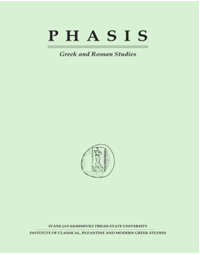
Submissions
Author Guidelines
Initial Submissions
Manuscripts submitted to Phasis must be original and must not have been published or be under consideration for publication elsewhere.
Normally, manuscripts should be no less than 5000 words in length (not incl. notes and bibliography). Since the journal follows a double-blind peer review process, the manuscript itself should not contain any indication of the author’s identity. There are no submission charges and no publication charges.
Authors should submit manuscripts as both a Word doc file and a PDF, together with an abstract of 150-250 words in English and contact information (name, affiliation, and address). Manuscripts should be double-spaced throughout, both main text and notes, and typed in a 12-point font. Pages should be numbered. Notes should be formatted as footnotes. A full bibliography of works cited should be included.
Manuscripts and other editorial correspondence should be sent to: phasis@tsu.ge
Peer Review Process
After an article is submitted to the journal, the editors screen the article and decide whether it should be rejected immediately or sent for peer review. If the decision is to review, the article is sent to two anonymous external reviewers, not affiliated with the same institution as any of the authors or editors. The journal follows a double-blind peer review process, where both the referee and author remain anonymous throughout the review process. The review process normally takes two to four months. After all referee reports are received, the manuscript is re-assessed by the editors. If the two reviewers disagree, the editor-in-chief may make a decision on publication or choose to send the article to a third reviewer. The reports along with the decision letter are sent to the author. At this stage, the decision may be one of the following: (a) accept, (b) accept with revisions, (c) major revisions needed and re-submission and re-review required, or (d) reject.
Once a submission has been accepted, the author should submit the final manuscript and all necessary permissions to reproduce illustrations. The final manuscript should be prepared in accordance with the journal’s style. Please follow the guidelines below:
Citations of Ancient Works
When citing ancient works, give the author’s name, the title of the work (this may be omitted if the author is known for one work), and the book, chapter, line, or other necessary numbers, separated by periods. Abbreviations for names of both authors and ancient works should follow the Oxford Classical Dictionary (4thed.). Examples:
Soph. Ant. 21-30.
Ar. Lys. 494-505.
Thuc. 2.18.5.
Od. 9.47-80.
Arist. Metaph. 1049b35-1050a25.
Use a Unicode font for Greek.
Notes should be formatted as footnotes. A full bibliography of works cited should be included.Below are examples of how to cite some of the most common types of sources in a bibliography (B) and footnotes (F).
Book by one author
(B) Duncan, Anne. 2006. Performance and Identity in the Classical World. Cambridge: Cambridge University Press.
(F) Duncan 2006, 58-70.
Book by more than one author
(B) Austin, Colin, and S. Douglas Olson. 2004. Aristophanes: Thesmophoriazusae. Oxford: Oxford University Press.
(F) Austin and Olson 2004, 51-55.
Edited volume
(B) Easterling, Pat, and Edith Hall, eds. 2002. Greek and Roman Actors: Aspects of an Ancient Profession. Cambridge: Cambridge University Press.
(F) Easterling and Hall 2002, 209-224.
Article
(B) Bryant, Arthur Alexis. 1899. “Greek Shoes in the Classical Period.” HSCP 10: 57-102.
(F) Bryant 1899, 67.
Article in edited volume
(B) Csapo, Eric. 2013. “Comedy and the Pompe: Dionysian Genre-Crossing.” In Greek Comedy and the Discourse of Genres, ed. Emmanuela Bakola, Lucia Prauscello, and Mario Telò, 40-80. Cambridge: Cambridge University Press.
(F) Csapo 2013, 59.
Article in proceedings
(B) Kennedy, David L. 1989. “The Military Contribution of Syria to the Roman Imperial Army.” In The Eastern Frontier of the Roman Empire: Proceedings of a Colloquium held at Ankara in September 1988 1, ed. D. H. French and C. S. Lightfoot, 235-246. Oxford, England: B.A.R.
(F) Kennedy 1989, 240.
Thesis or Dissertation
(B) Muhly, Polymnia. 1981. “Minoan Libation Tables.” Ph.D diss., Bryn Mawr College.
(F) Muhly 1981, 37.
Book review
(B) Crawford, Michael. 1989. Rev. of Andrew M. Burnett, Coinage in the Roman World. NC 149: 244-45.
(F) Crawford 1989, 244.
Copyright and Licensing
Authors retain the copyright. They grant the journal the right of first publication and permit the use of their work under a CC BY-NC [https://creativecommons.org/licenses/by-nc/4.0/] license, which allows others to download and share articles, provided that Phasis is credited as the source. The works derived from them can be used for noncommercial purposes only.

